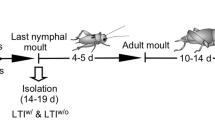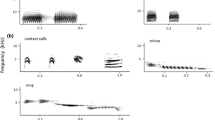Summary
The behaviour of a pair of herring gulls nesting in a colony of common terns and the reactions of the terns towards the gulls have been observed for eleven days. The terns were found to be highly aggressive to an adult gull flying in an area of about 150×150 meters around the colony and this reaction did not decrease in intensity during the observation period.
As hypothetical casual factors are mentioned: (a) The continuous alterations of peripheral qualities in the stimulus situation which breaks its constancy and prevents habituation to occur; (b) The attack response is reinforced each time an adult gull leaves the islet; (c) A habituation process took place but was concealed by a continuously increasing total aggressiveness from the terns as more eggs were hatched in the colony; (d) The mutual stimulating influence of the terns on each other; (e) The probable independence of the attack response to prior learning whereby it is included in a group of responses which are characterized by a high resistance to habituation. The gulls' situation is described as an approach-avoidance conflict, where equilibrium of the antagonistic drives results in conflict behaviour which gradually becomes more intense when closer to the nest as a function of increasing intensity of motivation.
Zusammenfassung
Das Verhalten eines Silbermöwen-Paares, das inmitten einer Flußseeschwalben-Kolonie auf einer kleinen Insel brütete und die Reaktion der Seeschwalben gegenüber den Möwen wurde 11 Tage lang untersucht. Die Seeschwalben verhielten sich einer Möwe gegenüber, die weniger als etwa 150 m von der Kolonie entfernt war, sehr aggressiv. Diese Reaktion blieb unverändert während der ganzen Beobachtungszeit. Als Ursachen für das Verhalten der Seeschwalben werden zur Diskussion gestellt:
-
a)
Die Reizsituation wechselt ständig und läßt daher keine Gewöhnung der Seeschwalben zu,
-
b)
Das Angriffsverhalten erneuert sich jedesmal, wenn eine Möwe die Insel verläßt,
-
c)
Eine Gewöhnung der Seeschwalben wird dadurch verdeckt, daß die Gesamtaggressivität der Vögel immer mehr zunimmt, je mehr junge Seeschwalben in der Kolonie schlüpfen,
-
d)
Der Einfluß wechselseitiger Stimulation unter den Seeschwalben,
-
e)
Das Angriffsverhalten könnte zu einer Gruppe von Verhaltensweisen gehören, die von Lernvorgängen unabhängig sind und daher keiner Gewöhnung unterliegen.
Die Möwe selbst befindet sich in einer Konfliktsituation zwischen Annäherung und Flucht, wobei das Gleichgewicht zwischen den einander widersprechenden Antrieben in einem Konfliktverhalten resultiert. Dieses Verhalten wird um so stärker, je mehr sich die Möwe ihrem Nest nähert und damit auch die Antriebe stärker werden.
Similar content being viewed by others
Literatur
Hinde, R. A. (1954a): Factors governing the changes in strength of a partially inborn response, as shown by the mobbing behaviour of the chaffinch (Fringilla coelebs): I. The nature of the response and an examination of its course. — Proc. Roy. Soc. B., 142, p. 306–331.
—— (1954b): Factors governing the changes in strength of a partially inborn response, as shown by the mobbing behaviour of the chaffinch (Fringilla coelebs): II. The waning of the response. — Proc. Roy. Soc. B., 142, p. 331–358.
Iersel, J. J. A. van, andBol, A. C. Angela (1958): Preening of two tern species. A study on displacement activities. — Behaviour, 13, p. 1–88.
Lorenz, K. (1939): Vergleichende Verhaltungsforschung. — Zool. Anz. Supp., 12, p. 69–102.
Melzack, R., Penick, E., andBeckett, A. (1959): The problems of “innate fear” of the hawk shape: an experimental study with mallard ducks. — J. comp. physiol. Psychol. 52, p. 694–698.
Melzack, R. (1961): On the survival of mallard ducks after „habitation“ to the hawkshaped figure. — Behaviour, 17. p. 9–16.
Nice, M. M., andter Perkwyk, J. J. (1941): Enemy recognition by the Song Sparrow. — Auk, 59, p. 195–214.
Orr, R. T. (1945): A study of captive Galapagos finches of the genus Geospiza. — Condor, 47, p. 177–201.
Ramsay, A. O. (1950): Conditioned responses in crows. — Auk., 67, p. 456–459.
Rydén, O. (1964): Vokal kommunikation hos släktetSylvia. — Unpublished paper.
Thorpe, W. H. (1963): Learning and instinct in animals. — London.
Tinbergen, N. (1953): The Herring Gull's World. — London.
Author information
Authors and Affiliations
Rights and permissions
About this article
Cite this article
Rydén, O. On the behaviour in an alarm-evoking, constant stimulus situation in a „natural experiment“.—Observations on a pair of Herring Gulls(Larus argentatus) and Common Terns(Sterna hirundo) breeding on the same islet. J Ornithol 111, 48–53 (1970). https://doi.org/10.1007/BF01668181
Published:
Issue Date:
DOI: https://doi.org/10.1007/BF01668181




